Yesterday’s liveblog can be found here. For an overview and analysis of this developing story see our latest podcast.
Please help The Interpreter to continue providing this valuable information service by making a donation towards our costs.
View Ukraine: April, 2014 in a larger map
For links to individual updates click on the timestamps.
Below we will be making regular updates. Be sure to check back often and hit refresh.
The U.S. Treasury Department has sanctioned an additional seven persons “for threatening the territorial integrity of Ukraine”, the department announced 20 June on its web site.
They are all pro-Russian separatists active in the southeast of Ukraine.
Interestingly, at the top of the list is Vyacheslav Ponomaryov, the self-proclaimed “people’s mayor of Slavyansk,” who was reportedly arrested and executed last week by his comrades in the “Donetsk People’s Republic.”
The following is the list of those sanctioned, bringing the total to date of persons sanction for the Ukraine conflict to 41 persons and 19 companies in Russia, Russian-occupied Crimea, and southeastern Ukraine.
Vyacheslav Ponomaryov, a separatist leader, has declared that the rebels have adopted a “take- no-prisoners” approach with future clashes with the Ukrainian security forces, claiming his men will “kill them all.” He also publically claimed his men would take all necessary measures to disrupt the Ukrainian elections in May. Ponomaryov is the former self-proclaimed “people’s mayor” of Slovyansk who declared himself mayor after leading a group of armed separatists in an assault on the Slovyansk mayor’s office in April. The town of Slovyansk has since become one of the centers of the separatist movement, and has been taken over by armed pro-Russia rebels.
Denis Pushilin is a leader of a group calling itself the “Donetsk People’s Republic,” which has seized government buildings across eastern Ukraine, declared itself to be a sovereign state, and requested that it be allowed to join the Russian Federation. Pushilin has overseen an uprising that has seized town halls, police stations, and other buildings in towns across Ukraine’s Donetsk region. Pushilin stated that he and his followers would not release the buildings they seized until the Ukrainian government vacated its government buildings and the Donetsk region got an independence referendum. At a May press conference, Pushilin also stated that civilian and military authorities independent of Kyiv would be formed in the Donetsk region following the results of the illegitimate referendum on the region’s status in May. He further stated that the presence of any Ukrainian military remaining in the Donetsk region after the announcement of the referendum’s results would be considered illegal.
Andrey Purgin describes himself as the co-head of a council running the separatist government in Donetsk. He advocated for the illegitimate May referendum and the federalization of Ukraine and took part in the storming of the Donetsk regional administration building earlier this year. Purgin founded the pro-Russian “Republic of Donetsk” organization in December 2005. The group’s activities were forbidden by a Ukrainian court, which considered them to be directed at the territorial disintegration of Ukraine.
Igor Girkin (who is also known as Igor Strelkov) is the self-described “commander-in-chief of the Donetsk People’s Republic” who controls a group of armed separatists in Slovyansk. Girkin is responsible for the abduction of military observers in Ukraine, and an attack on the Slovyansk Internal Affairs Administration and the 25th Air Mobile Brigade from whom he stole a large cache of weapons.
Valery Bolotov has proclaimed himself governor of the separatist-controlled Luhansk region and has publically declared war on the government in Kyiv. Bolotov took direction from Girkin to hold a sham referendum in Luhansk in May.
Sergei Menyailo is the de facto “acting governor” of Sevastopol. He assisted in the formation of Sevastopol’s self-defense squads, which played a key role in facilitating Russia’s occupation of the Crimea region of Ukraine and were later entered into the ranks of the Russian military. Menyailo is part of a commission established to ensure the effectiveness of Russian federal executive bodies in Crimea.
Valery Kaurov is the self-described “president of Novorossiya” and has called on Russian President Vladimir Putin to deploy troops to the territory described as Novorossiya. He has supported separatist activities in Ukraine’s Donetsk and Lugansk territories.
As a result of today’s action, any assets of the individuals designated today that are within U.S. jurisdiction must be frozen. Additionally, transactions by U.S. persons or within the United States involving the individuals designated today are generally prohibited.
The following is a partial transcript of the noon briefing for the press at the State Department concerning the subject of Ukraine and Russia, which has just been distributed.
QUESTION: Ukraine —
QUESTION: Has there been – has anyone asked for the assistance that you offered?
MS. PSAKI: I’m not aware of, but we’ve just offered to be helpful if we can be helpful.
Go ahead.
QUESTION: Ukraine.
MS. PSAKI: Sure.
QUESTION:
Earlier today the Russian ambassador to the United Nations denied that
Russian armed vehicles were crossing into Ukraine. How do you respond to
that?
MS. PSAKI: Well, I have a couple of updated details here, so let me run through those for you.
We are confident, as we said
last Friday, that Russia last week sent takes [sic] and rocket launchers from a
deployment site in southwest Russia into eastern Ukraine. We have
information that additional tanks have been prepared for departure from
this same deployment site, and that’s more recently. We also have
information that Russia has accumulated artillery at a deployment site
in southwest Russia, including a type of artillery utilized by Ukrainian
forces but no longer in Russia’s active forces, and believe Russia may
soon provide this equipment to separatist fighters.
And we are obviously closely
watching what we are seeing on the ground. I would also point you to the
comments of NATO Secretary General Rasmussen yesterday, who said we are
seeing a new Russian military buildup of at least a few thousand more
troops deployed at the Ukrainian border, and there are troop maneuvers
near the border with Ukraine.
And separately, we have our own
information that Russia has redeployed military forces to its border
with Ukraine. This is the closest Russian troops have come to the
Ukrainian territory since their invasion of Crimea.
So that is our view from the United States.
QUESTION:
The Russians say that the troop buildup that you and NATO have spoken
about is simply a border guard reinforcing and that they need to have –
they need to be reinforced because of the flow of – in some places, the
flow of people – refugees, some of them – across the border. You don’t
buy that? Is that —
MS. PSAKI:
Well, first, I think one step we’ve been asking President Putin and the
Russians to be supportive of is securing the border, and what we’re
seeing is a flow of individuals into Ukraine with materials and
equipment and tanks, as we’ve been speaking about. In terms of the
refugee numbers, we’ve looked into Russian reports of large numbers of
refugees fleeing Russia and have seen no evidence to —
QUESTION: No, no, no. Fleeing Ukraine.
MS. PSAKI: Fleeing for –
fleeing to Russia, sorry, fleeing to Russia, and have seen no evidence
to substantiate them. According to the Russian Federal Migration Service
itself, just over 5,000 people from Ukraine have applied for asylum in
Russia since January. And the numbers – some Russian sources are
claiming numbers more like 100,000. So we’re talking about the last six
months, I guess, since January. And many ethnic Russians from Ukraine
have family in Russia. Some may be staying with them, but neither
Ukrainian border guards nor international organizations operating in the
area have reported any large outflows of refugees to Russia to
substantiate their claim.
QUESTION: Okay. So but –
excuse me – apparently there was a meeting this morning of their –
whatever the Russian Government committee is that deals with refugees,
and they’re talking – I think they – unless I’m wrong, I think they were
talking about 9,000 or something like that. But to the best of your
knowledge, you’re saying that you have seen the only – you’ve seen
nothing like this, that there is no mass exodus or even close to
thousands that are crossing the border from Ukraine into Russia, fleeing
their homes or fighting? Is that —
MS. PSAKI: Correct. And
it’s not – obviously, just to clarify, though, it’s not the – we’re not
monitoring this ourselves, obviously. But the Ukrainian border guards
are as well as international organizations who are in the area.
QUESTION:
Okay. Does that mean that you don’t have any concern about the
situation in terms of what it means for civilians in the east right now?
MS. PSAKI: Well, I think
certainly we have concern, and – but we think the most effective and
powerful step the Russians can take is to call on separatists to lay
down their arms and to help secure the border. And obviously those are
the steps that we think would reduce the violence and tension in the
east.
QUESTION: Okay. Earlier
today a senior official was telling people that in addition to what you
just said about more tanks, additional tanks being prepared for – to be
transferred to the separatists, that some, in fact, as of yesterday had
actually moved away from this – from the site in southwest Russia. Do
you know (1) how many, and (2) in what direction they were moving – I
mean, and moving toward Ukraine?
MS. PSAKI: Well, to be
clear, we have information about – which I referred to specifically –
about preparing for departure from the same deployment site. We’ve seen
reports about additional Russian tanks, rocket launchers, and other
military equipment crossing the border into Luhansk. I don’t have
specific numbers, and those are reports. The other details are more
confirmed internally.
QUESTION: But – okay, I’m
a little confused now. So you don’t know that there are – that the
tanks have actually left this site in southwest Russia?
MS. PSAKI: There are
reports that they have. We know that they are preparing to depart, so –
but the reports are reports. I don’t have anything in —
QUESTION: Okay.
MS. PSAKI: — confirmation of those. There are reports out there that we’ve seen.
QUESTION:
In his conversation with Foreign Minister Fabius, you said that
Secretary Kerry talked about the Poroshenko ceasefire, which he has now
ordered a start of. The Russians have come back just within the last
half hour or so and said that this looks like an ultimatum and doesn’t
really look like a ceasefire. Can you be more – can you elaborate on –
more on what you think, what you – what the Administration thinks of the
ceasefire proposal, whether it’s an ultimatum or it’s a challenge and
not really a ceasefire?
MS. PSAKI:
Well, it’s a unilateral ceasefire, and certainly they need a partner in
order to – for it to be effective. But these are steps taken by
President Poroshenko and the Ukrainian Government to provide a path to
de-escalation. Obviously, the Russian separatists – or Russian-backed
separatists – would need to be a partner in that, as would the Russians,
in order to – for it to be effective on both sides.
QUESTION:
Okay. And then have you seen since – recognizing it’s only a couple
hours old now – but have you seen any indication from the Russians that
they’re willing to now take steps to – that you think would de-escalate
the situation?
MS. PSAKI: We have not seen new steps, and, in fact, I’ve pointed to some escalatory steps.
QUESTION: So in fact, they’re doing the opposite of what you say they should be doing?
MS. PSAKI: Correct.
QUESTION: All right. And still – there’s still no trigger, though, for these sectoral sanctions?
MS. PSAKI: Well, I know
we announced the sanctioning of seven new individuals this morning.
Early next week, as I noted, the Secretary will be at the NATO
ministerial meeting where Ukraine will be a big part of that
conversation, and there will also be a range of meetings among Europeans
next week, so we certainly expect these issues to be a big topic of
conversation.
QUESTION: So is this ambassador – this Russian ambassador to the United Nations, is he lying?
MS. PSAKI: I will let you put labels out there, Lucas, but I conveyed to you what we know as the United States.
QUESTION: Can I ask you a question?
MS. PSAKI: Sure.
QUESTION: I don’t know that you’ll be able to answer this, and you may want to just —
MS. PSAKI: Sure.
QUESTION: — refer it to Treasury, where I’ve already asked the question —
MS. PSAKI: Okay.
QUESTION: — and not
gotten an answer. The seven individuals who were identified in the
Treasury release and in a separate kind of fact sheet about them, and it
has information like dates of birth, in some cases places of birth.
Only one of the seven – for only one of the seven is the citizenship of
the individual specified. That person is Russian. Who are the other –
what is the nationality of the other six?
MS. PSAKI: It’s a good
question. I don’t know it off the top of my head. I will follow up with
them and see if that’s information that we can provide. As was noted in
there with the details in the press release, it’s more related to the
actions, and some of them are Russian-backed, so – but I will see if
there’s more we can provide.
QUESTION: Jen, who’s taking escalatory measures, the Russians or the Russian separatists?
MS. PSAKI: Well,
certainly the Russian separatists. But again, there’s no question in our
view that Russia has the ability to call on them to lay down their arms
and to secure the border, and there’s more that they can do to promote a
de-escalatory process.
QUESTION: I have one more on Russia.
MS. PSAKI: Sure, go ahead. Go ahead, Ali.
QUESTION:
In Russia, in the region, there was sort of the latest example of
Russia’s fabrication of stories. I would also defer to Matt on this line
of questioning, because it involved him, but –
QUESTION: I just wanted to stay clear of it, but go ahead.
QUESTION: But I just want to get your take on it, and what do you make of that story that was out there today.
MS. PSAKI:
Well, to be clear, and I used social media to tweet about this earlier
today, but there was a report about comments I made that were comments I
never made, and so I would first clarify that. But I would say broadly
speaking that the tactics of fabricated news stories and a range of
vicious personal attacks that I and others have been a victim of are not
steps you take when you’re operating from a position of strength. And
there’s no question that the more we talk about our support for a
strong, sovereign Ukraine, the greater the attacks become, so I will
leave it to others to draw their own conclusions on that front.
The White House Office of the Press Secretary released the following this evening. The statement is not on whitehouse.gov and was distributed by former Amb. Michael McFaul on his Facebook page.
Readout of the President’s Calls with Chancellor Merkel of Germany and President Hollande of France
The President spoke separately today with Chancellor Merkel of Germany
and President Hollande of France to consult about the crisis in Ukraine.The leaders welcomed President Poroshenko’s announcement of a
unilateral ceasefire and reemphasized the need for Russia to pull back
its destabilizing presence of military forces on the border of Ukraine,
stop the flow of weapons and militants across the border, and exercise
its influence among armed separatists to lay down their weapons and
renounce violence. They agreed that should Russia fail to take
immediate, concrete steps to deescalate the situation in eastern
Ukraine, the United States and the European Union would coordinate
additional steps to impose costs on Russia. The leaders also expressed
concern about the situation in Iraq and the threat posed by ISIL.
This video purportedly shows heavy gunfire and flares near the Izvarino border crossing between Ukraine and Russia:
The footage claims, and appears to be, taken much later at night than the incident described in the ITAR-TASS report we posted on previously.
We have not been able to precisely geolocate this footage however the title claims it was filmed at the Russian customs station.
The Russian state-owned news agency ITAR-TASS reports that “unidentified gunmen” have attacked the Ukrainian border checkpoint at Izvarino.
They report, citing Vasily Malayev, a press officer for the Rostov oblast branch of the FSB Border Department:
“Unidentified armed men attacked one more border crossing point from Izvarino (Ukraine) to Donetsk (Russia). At approximately 22:30 Moscow time [18:30 GMT] Ukrainian border guards came from the Izvarino station to the Donetsk side and asked for shelter from the armed men who were pursuing them. There are wounded among the Ukrainian border guards”, he said.
Malayev added that the wounded had given the necessary first aid. “They were evacuated to the nearest medical facility in the town of Donetsk (in the Rostov region)”, he said.
Translated by The Interpreter.
The office of the Ukrainian President, Petro Poroshenko, has published his proposals for a peace plan:
Peaceful plan of the President of Ukraine on the settlement of the situation in eastern regions of Ukraine:
1. Security guarantees for all the participants of negotiations.
2. Amnesty for those who laid down weapons and didn’t commit serious crimes.
3. Liberation of hostages.
4. Establishment of 10 km long buffer zone on the Ukrainian-Russian border. Withdrawal of illegal armed formations.
5. Secure corridor for the escape of Russian and Ukrainian mercenaries.
6. Disarmament.
7. Establishment of units for joint patrolling in the structure of the MIA.
8. Liberation of illegally seized administrative premises in Donetsk and Luhansk regions.
9. Restoration of functioning of local government.
10. Restoration of central television and radio broadcasting in Donetsk and Luhansk regions.
11. Decentralization of power (through the election of executive committees, protection of Russian language; draft amendments to the Constitution).
12. Coordination of governors with representatives of the Donbas before the elections (in case of the approval of single candidature, in case of discrepancies – the decision is taken by the President).
13. Early local and parliamentary elections.
14. Program of creating jobs in the region.
15. Restoration of industrial objects and objects of social infrastructure.
The BBC reports that Poroshenko also announced that he would invite the OSCE to monitor the ceasefire.
However they note that the Russian government has not reacted enthusiastically to the ceasefire announcement:
The Kremlin dismissed the truce, saying it was “not an invitation to peace and negotiations but an ultimatum”.
Ukrainian news agencies quoted a senior rebel commander as saying the insurgents would not lay their arms until government troops had left the region.
Tatiana Pogukai, the head of the public relations department of the Lugansk regional branch of the Interior Ministry, has written on her Facebook page about a violent attack in Krasnodon.
In Krasnodon armed men have fired at a shuttle bus carrying miners. One person was killed and six wounded.
Today at 16:00 [13:00 GMT] in the centre of the town of Krasnodon, on Artem Street, men armed with automatic weapons, dressed in camouflaged clothing, fired on an Iveco shuttle bus in which miners were travelling from work (10 people in total with the driver).
As a result of the shooting, 1 man was killed on the spot and 6 people were admitted to hospital with gunshot wounds.
Krasnodon was also the location of the first sighting of the unmarked Russian military convoy today. The town lies extremely close to the Russian border.
We have some more information on the tanks sighted in Alchevsk which we reported earlier, and for which @djp3tros has provided what we consider a convincing geolocation.
YouTube user Novo Ukraina has uploaded the same video today reporting a Russian military convoy in Alchevsk in Lugansk Region, Ukraine, heading toward Perevalsk and Slavyansk.
The convoy had numerous vehicles, and at least 20 tanks, 5 BTRs and 11 trucks. The viewer also spotted anti-aircraft weapons chained to one vehicle. On one of the BTRs, the insignia of the “Almighty Troops of the Don” were seen, a registered Cossack organization.
We were unable to confirm all the information.
Here’s an additional video uploaded June 19th by Lenta Novostei (Newswire), said to be early in the morning at Gukovo.
It seems to show the same column of Russian armored vehicles yesterday, moving toward the border, with close-ups of vehicles and personnel. Russian flags are on a number of the vehicles, and one flag may be the Russian airborne troops’ flag.
The videographer said he counted 25 BTRs with 3 GRADs passing over the border.
“Today the Russian border crossing of Novoshakhtinsk was shelled by Ukrainian forces. There are damages. A customs officer is severely wounded.
Russia expresses its decisive protest in connection with this aggressive action. We demand from Kiev an urgent and immediate investigation of all the circumstances of this crime which has violated the elementary norms and principles of international law.
This is a question of outright provocation, whose purpose is not to allow the implementation of the Geneva accords on the rapid de-escalation of the internal Ukrainian conflict.
How can this be compared to the statements today of the Kiev authorities regarding the ceasefire?”
Meanwhile, the Ukrainian military has denied the claim, saying “it did not use artillery and mortars during action to restore the state border in the east of Ukraine,” unian.net reported.
The Ukrainian Armed Forces said that an ATO (anti-terrorist operation) was conducted near the border crossing of Dolzhansky at the Ukrainian-Russian border. Separatists have been occupying this border post for some time, and put up a “desperate” armed resistance to government troops, says unian.net.
When they opened a barrage of chaotic gunfire, the
fighters tried to hold their positions. At one point in the clashes a
mortar mine exploded near the border line. According to information from
the Russian government, a representative of the Russian Federation
customs service was wounded.
A military spokesperson said:
“In that connection, the Defense Ministry of Ukraine Department of Press and Information is authorized to state that despite the proximity to the state border with the Russian Federation, artillery or mortars were not used and are not being used by Ukrainian military
But terrorists, for whom it is important to organize a provocation with the purpose of destabilizing the border regions are actively using their available heavy artillery and mortars.”
A young recruit from the Russian army reportedly called his mother and said, “We have all been changed into Ukrainian military informs and deployed in Ukraine…many are already in Ukraine…I don’t know for what…”
UAinfo.org is also citing a report from residents of Rostov Region in Russia near the Ukrainian border who said they saw military men in Ukrainian uniforms who spoke with the broad “As” of the Muscovite accent in Russian, not the accent of Russian-speakers in Ukraine.
Reports have also reportedly surfaced on Twitter of “dressed-up Russian soldiers near the Ukrainian border,” says UAinfo.org.
We have not been able to confirm any of these reports but they are consistent with efforts to mask the true Russian military presence in Ukraine in the past.
The Russian Foreign Ministry has issued a tart communique following a telephone conversation with Ukrainian Foreign Minister Klimkin. The Interpreter has provided a translation:
“With surprise we have learned of the commentary on this conversation made by the Foreign Ministry of Ukraine in which the support by the ministers is claimed of the Ukrainian President’s plan ‘with an emphasis on effective control of the Ukrainian border.’
First of all, this does not correspond to reality. It is hard to support what does not yet exist in reality. We would like to underscore once again that in the telephone conversation with our Ukrainian colleague, S.V. Lavrov called on Kiev to hold talks with those who really control the situation in the South East of Ukraine.”
Earlier, Kiev had unilaterally declared that it was demarcating and closing the border. But with this statement, Russia is saying that it does not recognize the Ukrainian border and feels free to deal with separatists who have taken over border posts in recent weeks and control movement across the southeast of Ukraine.
A citizen reporter has uploaded a video time-stamped in the last hour of more Russian tanks and BTRs spotted in the Russian town of Gukovo near the Ukrainian border.
The video shows a group of people standing at a bus stop who all salute the tanks in unison.
The location of the tank spotted in Gukovo has been confirmed on Google Maps Street View on ul. Karl Marx Street.
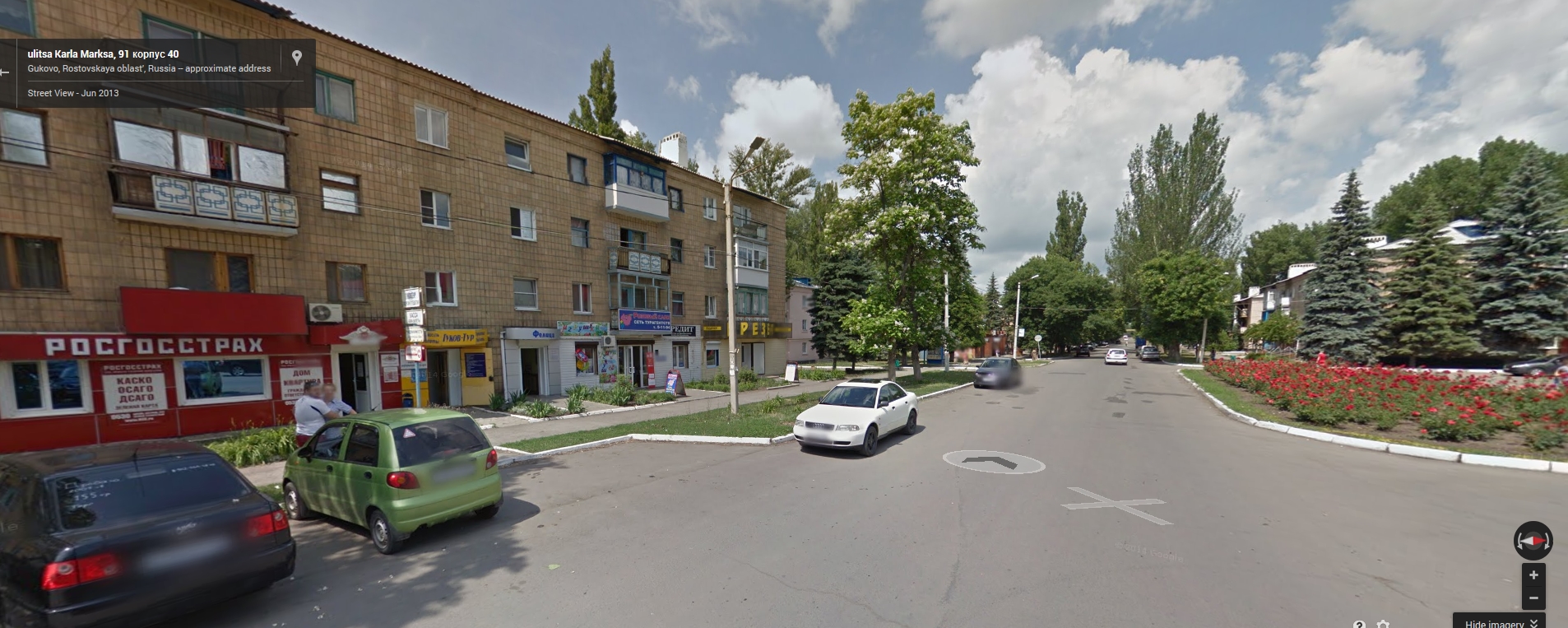
Russian authorities are preparing tent cities for what they anticipate will be massive flows of refugees from Ukraine, the state news agency RIA Novosti reported this evening.
The announcement came within a context of an official justification for invasion of Ukraine — the need to make a “humanitarian corridor” to ensure the safety of civilians fleeing armed conflict between pro-Russian separatists and Ukrainian military.
Officials say the ability to host refugees temporarily in Rostov Region is “virtually exhausted,” but there are people who prepared to take them in, Gov. Vasily Golubev told Baltkom today.
Golubev claims there are already 7,000 refugees in his region from the conflict in Ukraine, although the Russian media has been found to exaggerate the numbers and the situation requires further investigation.
Here’s what RIA Novosti says, although it has not been confirmed by the UN High Commissioner for Refugees or any other independent authority. Note that even within this one article, the numbers cited by the governor and the news agency itself differed:
“Since June, due to the aggravation of the situation in the southeast of Ukraine, the flow of refugees into Russia rose sharly, including in the Rostov Region near the border. Every day, about 10,000 citizens of Ukraine are entering, some of whom remain in the region, and others who are transiting through. According to the Russian Emergencies Ministry, more than 10 Russian regions are now active in accepting refugees from the southeastern regions of Ukraine.
In order to receive refugees in the south and center of Russia, already more than 200 temporary placement areas have been opened, including tent cities. There are now 9,700 people in the temporary placement facilities, including 5,300 children. Another 12,000 people are placed with relatives and acquaintances.”
Petro Poroshenko has decreed a ceasefire in eastern Ukraine. Below The Interpreter has translated a report from Interfax.
At National Guard’s Anti-Terrorist Center Headquarters, Poroshenko Announces Decree on Ceasefire in East
17:47 pm
Ukrainian President Petro Poroshenko arrived at the National Guard’s Anti-Terrorist Center where he announced his intention to sign a decree on a temporary ceasefire in the immediate future.
“As the president noted, he will soon sign a decree on a temporary ceasefire. This is being done in order to enable the terrorists to put down their weapons, and those who do not do this, will be destroyed,’ the report on the site of the Ukrainian Interior Ministry stated on Friday.
The statement notes that also at the [National Guard] camp was Arsen Avakov, head of the Interior Ministry, Andrei Parubiy, secretary of the council for National Security and Defense, and Stepan Poltorak, commander of the National Guard.
Poroshenko handed out state awards and military equipment (thermovision cameras and binoculars) to the soldiers of the National Guard.
Earlier Valery Chaliy, deputy head of the presidential administration announced that on Friday, the peace plan for eastern Ukraine proposed by Poroshenko will be announced.
But it seems that some have already accused Poroshenko of bowing to pressure from Russia in light of today’s small-scale invasion and the growing number of Russian troops preparing to cross the border.
According to a source at the Ministry of Defence, army units and military equipment are drawing up to the Russo-Ukrainian border. That they are equipped with engineering and construction equipment as well as fuel tankers and medical battalions indicates that the military is here to stay for a long time. RBK reports this citing a source in the Ministry of Defence.The source also confirmed to the agency reports that scenarios are being worked out for Russian forces in Donetsk and Lugansk to create a so-called “humanitarian corridor” in the Donbass.“Indeed, such a possibility is being studied: within days of receiving the order the military would need to create screens between the civilian population and the Ukrainian army, and propose an ultimatum to the opposing side on the need for a ceasefire. The use of force is only possible in the event of fire in our direction”, said the military source.
Translated by The Interpreter.
Ukraine had relaunched a far more robust anti-terrorism operation in the east after multiple rebel victories had secured Ukrainian military bases, border posts, and National Guard installations. Russia responded by sending its troops to the border and today those forces have already started to cross into Ukraine according to many reports today.
The separatists were losing ground, and now it looks like Russia has come to their rescue.
A closer inspection of a video of Russian armoured vehicles being transported near the border at Millerovo yesterday shows that a number of the vehicles are unmarked, like those seen in eastern Ukraine.
Compare the camouflage and numbering visible on the T-80 tank here: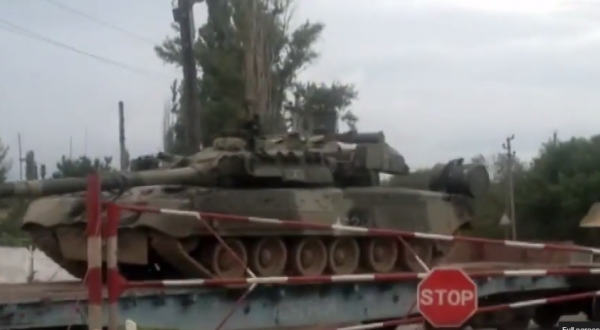
With the following screenshot showing an armoured vehicle (perhaps an 1V16) in the same uniform drab green paint as seen on the T-64s seen in Ukraine today:
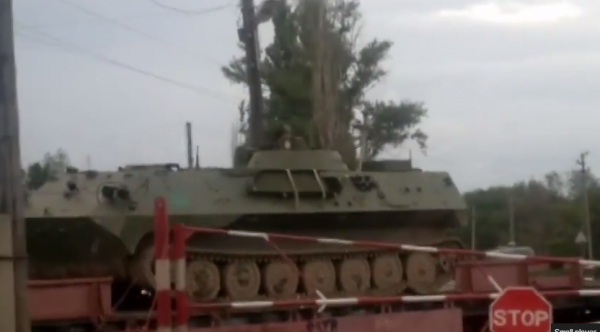
Note also that the vehicle carries no numbering.
Also seen with blank markings in this convoy is a 2S1 Gvozdika self-propelled howitzer:
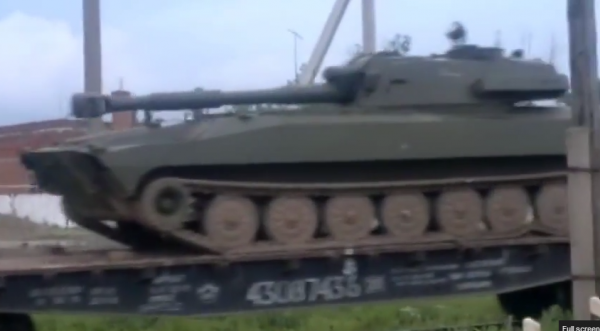
It is worth noting that the Gvozdika is an older model which, in addition to being in Russian service, is also employed by Ukraine.
Have these vehicles been prepared for operations in Ukraine?
Meanwhile, @djp3tros has pointed out that a column, greatly resembling that seen earlier today in Lugansk, was filmed in the early hours of the morning in Krasnodon, right on the border with Russia:
He provides the following geolocation:
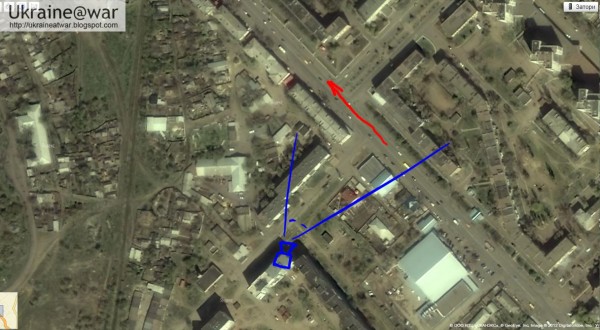
Given this information, it appears extremely unlikely that the military column could have originated anywhere other than Russia.
Mikhail Koval, the Ukrainian defence minister, announced today at the Rada that a Grad rocket launcher used by the separatists had been identified by documents as belonging to a Russian army unit. He also commented on the fates of the T64 tanks which were seen near Snezhnoye last week. His address does not however discuss today’s unprecedented movements of apparently Russian armour in the East.
Ukrainska Pravda reports, translated by The Interpreter:
“We have had operational reports that 10 Grad BM-21 military vehicles have crossed the Ukrainian state border and are in Ukrainian territory”, said Koval.
According to him, one vehicle has been caught and destroyed.
The Ukrainian military have found evidence that it belongs to the Russian army.
“Inside it, we found evidence that suggests that this was a vehicle from the 18th motor rifle brigade from Chechnya, in the southern military district of the Russian Federation. There were notebooks, firing maps and stamps from this brigade”, said Koval.
In addition to this one, the Ukrainian military has discovered 6 more of such vehicles.
“We are maintaining visual contact with them. And once they come within shooting range we will open fire at once. Our actions are denying them the opportunity to open fire accurately”, he said.
“We have recorded only two occasions when the rocket launchers have opened fire. This was the settlement of Belopole and, secondly, Ambrosievka”, noted Koval.
He also reported on the spotted tanks.
“Regarding the tanks: we identified three tanks, two of them were damaged last week in the area of Saur-Mogila. One was completely destroyed, the other was successfully evacuated by our enemies. These T-64 tanks are from the Russian army, without numbers”, said the head of the Ministry of Defence.
In addition, according to Koval, the enemy have 2 IS-2 tanks, which they removed from pedestals – one of them is moving.
Five BTRs have also been spotted.
We note that, as yet, there has been no photo or video evidence of the destruction of the T-64 referred to by Koval.
The IS-2 tanks to which Koval refers were taken from war memorials. There is footage of a similar IS-3 tank, which dates from the very end of the war, being reactivated by separatists on YouTube:
There have now been multiple sightings, recorded on video, of a column of Russian forces including tanks, APCs and military trucks progressing as far as Gorlovka in the Donetsk region.
This video, which we believe has been successfully geolocated by @djp3tros on his ukraineatwar blog appears to show the column entering Lugansk from the south-east.
The location of suggested by @djp3tros, and checked by ourselves, is here:
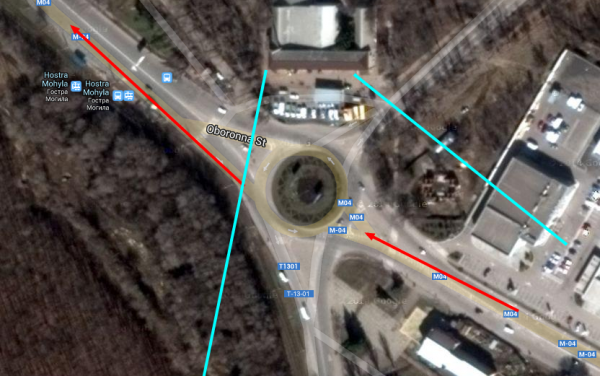
This is a video that appears to show the same column of vehicles, seen in our previous update, elsewhere in Lugansk. There are at least 4 tanks and 5 BTRs along with numerous military trucks and private cars and vans.
A look on Google Maps suggests that this may be location of the video. Note the match in the appearance main exits from the roundabout and the small turn-off visible in the video to the lower right (seen on the northern side of the roundabout on the map).
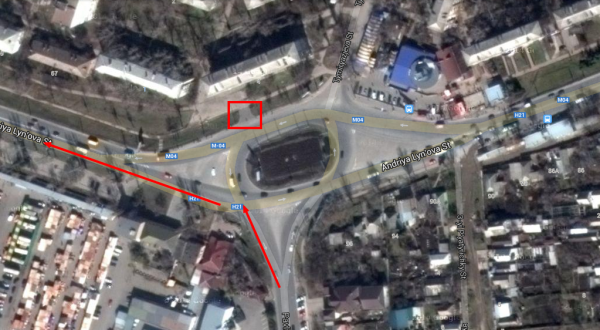
The location suggested by @djp3tros for the video we posted earlier is here, just to the west of the location above. We think that this match is accurate, given the distinctive building visible in the video.
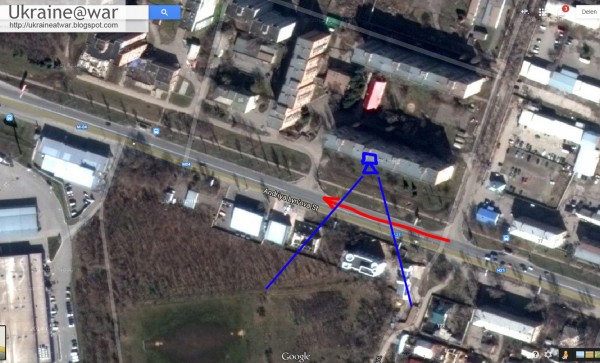
Here is another video, to the west of Lugansk now, in Alchevsk. Again @djp3tros has provided what we consider a convincing geolocation.
Most recently, the vehicles have been filmed in the separatist held town of Gorlovka:
Once more, we thank @djp3tros for providing another geolocation of this video, which have checked and appears to be correct.
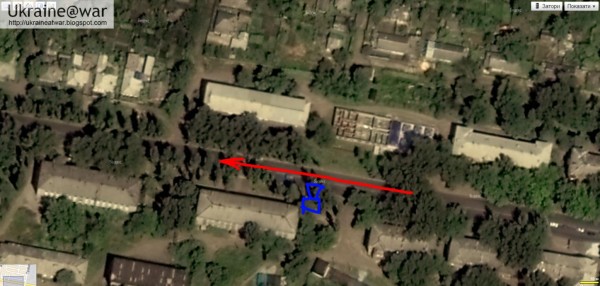
Thus, we can plot a basic route from this videos:
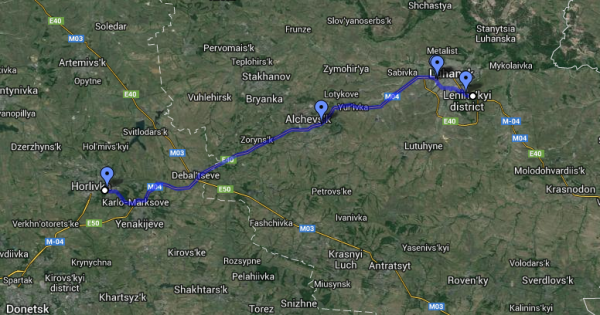
These photos, which we haven’t verified yet, but which do appear to show the same column, we purportedly taken near Debaltseve, which would fit with the prospective route above.
These developments are extremely worrying. We should note that we have never before seen such an enormous show of force from separatist fighters, and that these unmarked T-64s do not match the appearance of Ukrainian ones we have seen, such as one shown in a recent video.
Following the appearance of three similarly unmarked T-64BVs last week, NATO issued a report in which they said that the vehicles had most likely come out Russian reserve storage and crossed the border.
With video emerging that appears to show a large quantity of Russian heavy armour being ferried by rail close to the border at Millerovo (notably close to Lugansk) yesterday, it appears that an outright invasion by Russia may already be beginning.
A number of Ukraine-watchers on social media are speculating whether the long-anticipated Russian invasion is underway.
Some think so:
The question is: which Russians?
There are reports of numerous military vehicles rumbling through Lugansk this morning, bearing the flags of Crimea and the black-and-orange St. George banners.
Does that suggest, as some are speculating, that forces from Russian-occupied Crimea are entering
the Ukrainian mainland rather than from Russian Federation territory?
But how did they cross the border from Crimea, then, which is supposed to be “under lock and key”? In fact, Dmitry Tymchuk of Information Resistance announced this morning that the Ukrainian military is finishing up a border-closure operation.
Tymchuk also said that 2 T-64 tanks had entered Lugansk and 5 BTRs [armored transport vehicles[.
And the National Guard is declaring that they have seized a Russian BTR in Donetsk Region, Interior Minister Arsen Avakov has reported on his Facebook page.

We have not confirmed this information.
The Interpreter has provided a translation of Avakov’s post:
Last night, during an attempt by a group of terrorists to break through on the Russian side in the region of Maryinovka, deep into Ukrainian territory, divisions of the national Guard of Ukraine seized a BTR-80. Terrorists were partially destroyed and partially detained.
In the photos below its the BTR seized and its record book. Note the stamp of the Russian military unit. That is for diplomats and doubters.
There are the great words of the great Russian warrior. Putin must remember them. “Who comes to us with the sword, will perish by the sword!” Glory to Ukraine!

